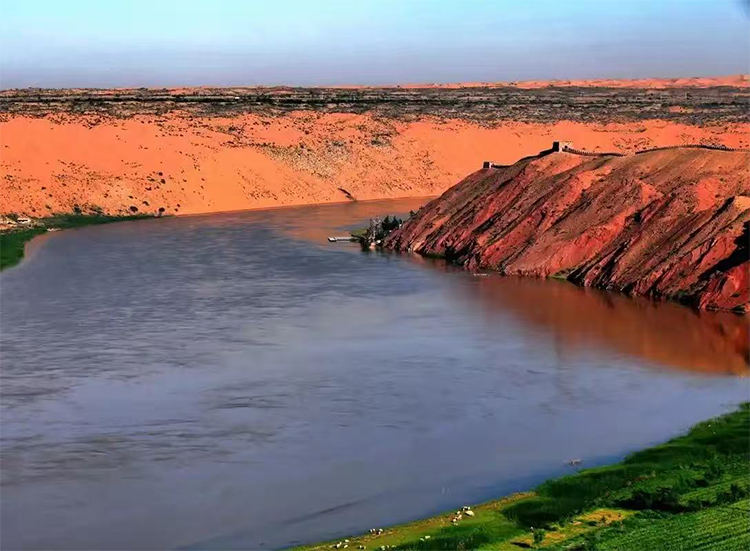Shapotou Desert & Yellow River Adventure: Exploring Silk Road History
Introduction
When the golden Tengger Desert meets the surging Yellow River, a natural and cultural epic unfolds. Shapotou, a 5A attraction in Zhongwei, Ningxia, is celebrated as a global model for desert control, a landscape of dramatic dunes and river bends, and a living echo of the Silk Road. Walk across straw checkerboard grids that rebuilt the dunes, float on seasonal sheepskin rafts to hear the river’s pulse, or slide down booming sand slopes to feel the earth sing. Shapotou is an open-air museum of human–nature coexistence.
1. World’s Only Desert & Yellow River Symphony
The vast loneliness of the desert and the Yellow River’s mighty flow collide here to create a rare landscape. The park centers on two complementary zones:
– Yellow River Zone: The “First Great Bend” of the Yellow River sweeps like a dragon’s turn. Seasonal sheepskin raft rides let you touch water carrying loess particles and evoke the ancient imagery of rivers and islets in Chinese verse.
– Desert Zone: The booming sand phenomenon—when sand grains sliding down hundred-meter dunes roar like distant thunder—once convinced locals there was a bell under the earth. This area is also the birthplace of the straw checkerboard (maicao grid) technique, the simple grass grids that successfully locked migrating sand and earned international praise as a leading anti-desertification innovation.
2. Silk Road Desert Waystation Legends
As a chokepoint on the northern Silk Road, every grain of sand here holds history:
– From the Han dynasty onward, caravans led camels across this corridor toward the West; the echo of camel bells once reverberated across Eurasia. Remnants of caravan trails remain, and a 30-minute camel ride (about ¥100) lets you imagine ancient envoys like Zhang Qian passing by.
– During the Northern Song period this area served as a strategic outpost for the Western Xia state; the natural barrier of desert and river tested countless armies. From the Wangwei viewing platform you can still feel the frontier poetry of sand, dust, and dusk.
3. Year-Round Experiences: When to Visit and What to Expect
Best season: May–October (summer daytime averages around 25°C—an unexpected desert cool retreat).
– Spring (Mar–Apr): Green shoots appear across the sand, wild saxaul dots the landscape—ideal for photographers chasing a “frontier spring” aesthetic.
– Summer (Jun–Aug): Try the Yellow River zipline for an adrenaline rush, and experience the most spectacular starry skies while camping on the dunes.
– Autumn (Sep–Oct): Dune ridgelines glow like golden waves in the slant sunlight—camel treks feel like stepping into an ancient western painting.
– Winter (Nov–Feb): Rare desert snow drapes the dunes in silence; fewer visitors mean a private, austere beauty.

4. Adrenaline & Cultural Immersion—Top Activities
Adrenaline experiences:
– Yellow River zipline (¥80 per ride): A 3-minute swoop across the river, offering birds-eye views of the S-shaped great bend.
– Desert buggy (¥150 for 15 minutes): Hurtling down 45° dunes delivers brief weightlessness and pure thrill.
Cultural experiences:
– Straw checkerboard workshop (¥30, includes explanation): Try your hand at the technique recognized among global conservation efforts—understand how simple grids changed the landscape.
– Western Xia kiln site tour: Touch ancient black-glazed pottery shards and hear experts decode the role of ceramics in Silk Road trade.
5. Practical Info: Getting There, Tickets, and Local Tips
Transport:
– About a 2-hour drive from Yinchuan via the Beijing–Tibet (G6/Jingzang) expressway then S201, or take the Zhongwei tourist shuttle (¥15 per person, daily departures at 8:00 and 14:00).
Tickets:
– Peak season (Apr–Oct): ¥80; off-season (Nov–Mar): ¥40 (includes the desert museum).
– Combination ticket (admission + sightseeing bus + sandboarding) around ¥180; students half price.
Local tips:
– Arrive before 6:00 at Mingzhong Pavilion (Bell Pavilion) to enjoy the empty golden sea of sand at sunrise.
– Try the roadside desert melon at the exit (seasonal in August) and Ningxia goji berries for an excellent local souvenir.

Conclusion
Shapotou is more than a postcard view; it’s a geological and cultural chronicle written in sand. You’ll understand why travelers once called this a frontier paradise and why the straw checkerboard stands as a testament to Chinese ecological ingenuity. When your footprints overlap ancient caravan tracks, this blend of natural spectacle, historic resonance, and conservation wisdom becomes a key to the spirit of northwest China.


